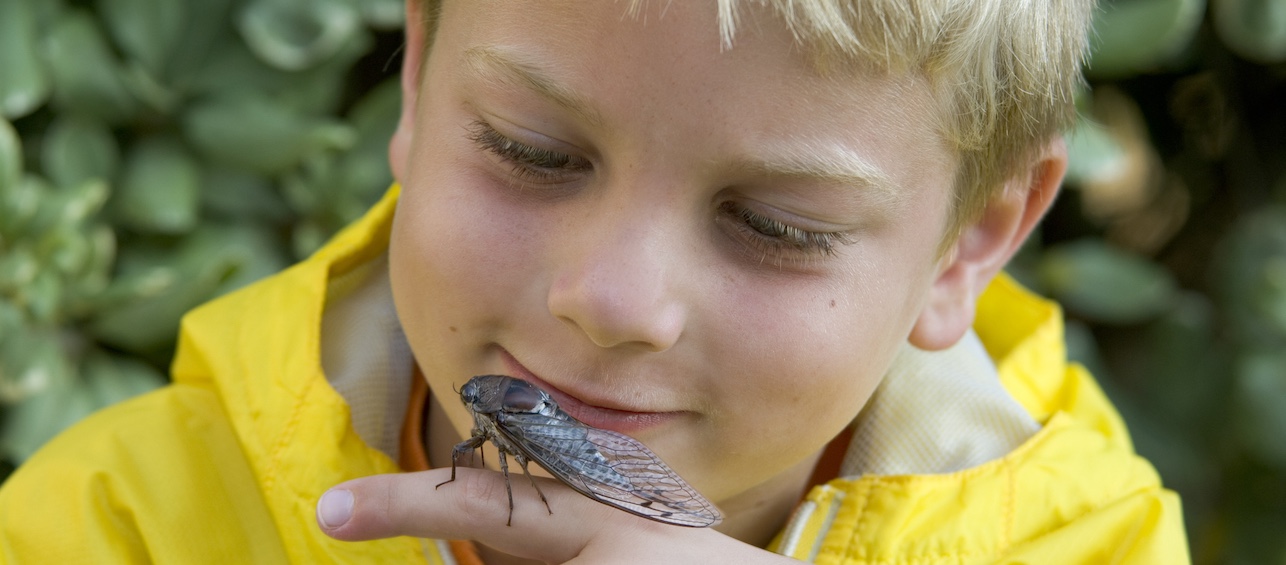Billions of cicadas will be emerging across the United States this summer. We can expect to see them around the Southern Ohio area from around mid-May to late June.
Brood XIV (14) is a group of periodical cicadas that emerge every 17 years. This brood has been underground since 2008. For some, this may be the first time experiencing this phenomenon. And while some kids find cicadas fascinating, these insects can cause trouble for others.
WHY DO SOME KIDS FIND CICADAS SCARY?
Cicadas can be very loud, especially when there are large numbers of them in a single space. Their song can reach as high as 100 decibels. That’s about as loud as a motorcycle.
Some people think they aren’t the prettiest creatures. They have big red eyes and large brownish-orange wings, which can be scary for children who aren’t insect-lovers.
GOOD NEWS: CICADAS ARE HARMLESS
But there is good news about these buzzy friends: They are harmless. These insects don’t bite or sting.
They are, however, clumsy fliers and may land on you or your child, which could cause some panic or anxiety.
HOW TO PREPARE CHILDREN FOR A CICADA SUMMER
To help prepare your kids for the cicadas coming this summer, I recommend using this Cicadas Social Narrative created by the University of Cincinnati Center for Excellence in Developmental Disabilities (UCCEDD).
To find the social narrative, visit the UCCEDD’s Resources page. Scroll to the section titled “Family Support” and click on the link under “Cicadas Social Narrative.”
WHAT IS A SOCIAL NARRATIVE?
Social narratives are a helpful learning tool to teach children something new or explain new situations. They can help all children but are especially useful for kids with autism, sensory issues or anxiety.
Social narratives prepare children and often reduce stress or worry. They are visual and use simple language, which aids in children’s understanding.
A few situations where our Division of Developmental and Behavioral Pediatrics suggests that families use social narratives include:
- Going to the dentist
- The first day of school
- Getting blood drawn
- Cicadas emerging
HOW TO USE A SOCIAL NARRATIVE
Social narratives are incredibly flexible. They can be paper or electronic. They can be all visual or visual with minimal text. They can be formatted like a book, electronic pdf, comic strip, or PowerPoint. You can even make your own using real pictures of your surroundings.
The key is to understand your child’s learning style and choose the best format for them. Repetition is important. Read the social narrative with your child several times. Talk about the information in it in a positive way. If you have printed out the social narrative, leave it where they can explore it on their own to expose them repeatedly.
ADDITIONAL TIPS
In addition to using the social narrative, try these strategies to get your child ready for this summer’s cicada brood.
- Be positive about cicadas. Explain that this a rare experience to witness, and the next time they see Brood XIV will be 17 years from now. Let your child explore cicadas in their own way. Take them outside and find a cicada for them to look at and touch if they feel comfortable.
- Explain that this is a short-term event. It’s important for kids to understand that Brood XIV will not be here forever. Reassure your child that cicadas won’t hurt them during their visit.
- While I encourage outdoor activity, if your child wants to stay inside more than usual, that’s okay. If the insects are causing a lot of stress, your child can play inside temporarily. To encourage being outside, research when cicadas are least active and take your child outdoors during those times, even if just for a short while.
- Use noise-canceling headphones. Cicadas can be very loud. For kids with autism or sensory issues, the sound can be upsetting. Use noise-canceling headphones to help your child tolerate the cicadas’ singing.
We know these little creatures can be a lot for children to digest. I hope that using the social narrative and following the advice above will bring your child comfort as they adjust.



